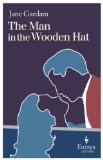Summary | Excerpt | Reviews | Beyond the Book | Read-Alikes | Genres & Themes | Author Bio

Critics' Opinion:
Readers' Opinion:
First Published:
Oct 2009, 240 pages
Paperback:
Oct 2009, 240 pages
 Book Reviewed by:
Book Reviewed by:
BookBrowse Review Team
Buy This Book
This article relates to The Man in the Wooden Hat
Although Elizabeth does not talk about her experience in a Japanese internment camp during World War II except to mention that her parents died there, its memory definitely colors her feelings about Hong Kong. While we do not know for sure, it seems likely that the camp she was interned in was the Stanley Civilian Camp - a non-segregated camp in the grounds of Stanley Prison and the neighboring secondary school, St Stephen's College, on the southern end of Hong Kong's main island. The camp was home to about 2500-2800 civilian men, women and children from January 1942 to August 1945 when the Japanese surrendered.
According to Kevin Blackburn in his book
Forgotten Captives in Japanese Occupied Asia, within the first six months of the beginning of the war in the Pacific the Japanese captured over 132,000 enemy nationals, of whom some 50,000 were British. Over the duration of the war (1941-1945) they experienced a 25% death rate overall. At Stanley the death rate was not as high, around 10%, and was primarily credited to malnutrition and, what a report by the then British Secretary of State for Foreign Affairs referred to as, "organic illnesses." Blackburn notes that the Japanese considered the thousands of POWs "a side issue," not as big a priority as ruling the captured locations. Indeed, Geoffrey Charles Emerson, author of Hong Kong Internment, 1942-1945: Life in the Japanese Civilian Camp at Stanley notes that for the first several months the internees were mostly left to fend for themselves.
 The vast majority of the people held at Stanley were British, especially after most American and Dutch nationals were repatriated in mid-1942. The remaining captives formed committees to attend to basic needs of food, clothing (most people, rousted from their homes without warning, had only the clothes on their backs), health care and so on. Food was said to consist principally of rationed
dirty rice infested with bugs and rodents, plus a small serving of something
resembling stew as one of the two daily meals. The Red Cross and various
charitable groups, as well as friends and family of internees on the outside,
often sent packages of much-appreciated provisions.
The vast majority of the people held at Stanley were British, especially after most American and Dutch nationals were repatriated in mid-1942. The remaining captives formed committees to attend to basic needs of food, clothing (most people, rousted from their homes without warning, had only the clothes on their backs), health care and so on. Food was said to consist principally of rationed
dirty rice infested with bugs and rodents, plus a small serving of something
resembling stew as one of the two daily meals. The Red Cross and various
charitable groups, as well as friends and family of internees on the outside,
often sent packages of much-appreciated provisions.
Although deaths at Stanley were not of an extraordinarily high number Emerson
describes instances where internees were either tortured or executed, or both,
as their fellow prisoners were forced to stand by and watch helplessly.
Photo of a former internee, taken after the camp was liberated in 1945, holding the daily ration for her room, which housed five people (from the Imperial War Museum online collection)
Filed under People, Eras & Events
![]() This article relates to The Man in the Wooden Hat.
It first ran in the November 5, 2009
issue of BookBrowse Recommends.
This article relates to The Man in the Wooden Hat.
It first ran in the November 5, 2009
issue of BookBrowse Recommends.





The House on Biscayne Bay
by Chanel Cleeton
As death stalks a gothic mansion in Miami, the lives of two women intertwine as the past and present collide.

The Flower Sisters
by Michelle Collins Anderson
From the new Fannie Flagg of the Ozarks, a richly-woven story of family, forgiveness, and reinvention.

The Funeral Cryer by Wenyan Lu
Debut novelist Wenyan Lu brings us this witty yet profound story about one woman's midlife reawakening in contemporary rural China.
Your guide toexceptional books
BookBrowse seeks out and recommends the best in contemporary fiction and nonfiction—books that not only engage and entertain but also deepen our understanding of ourselves and the world around us.